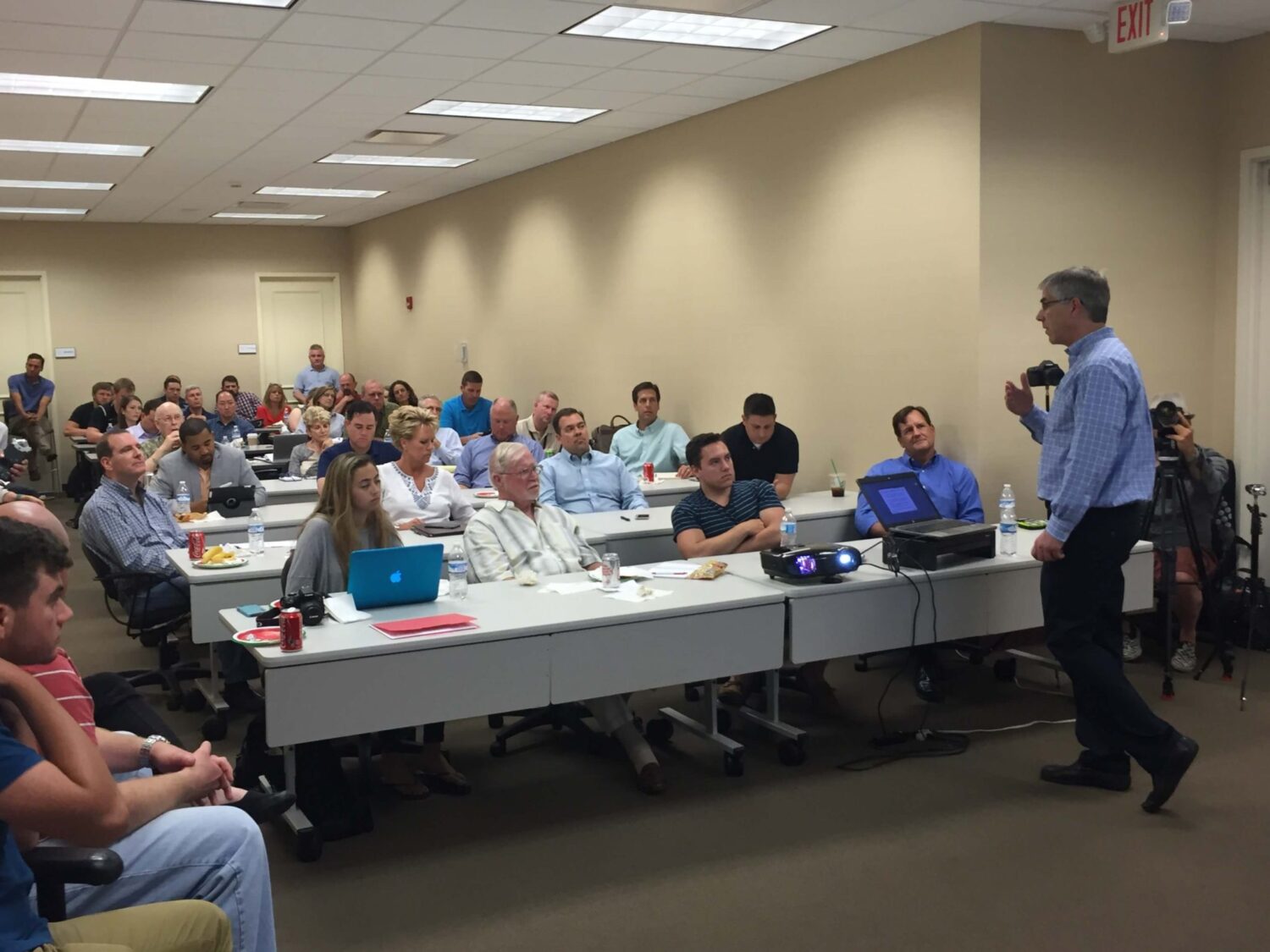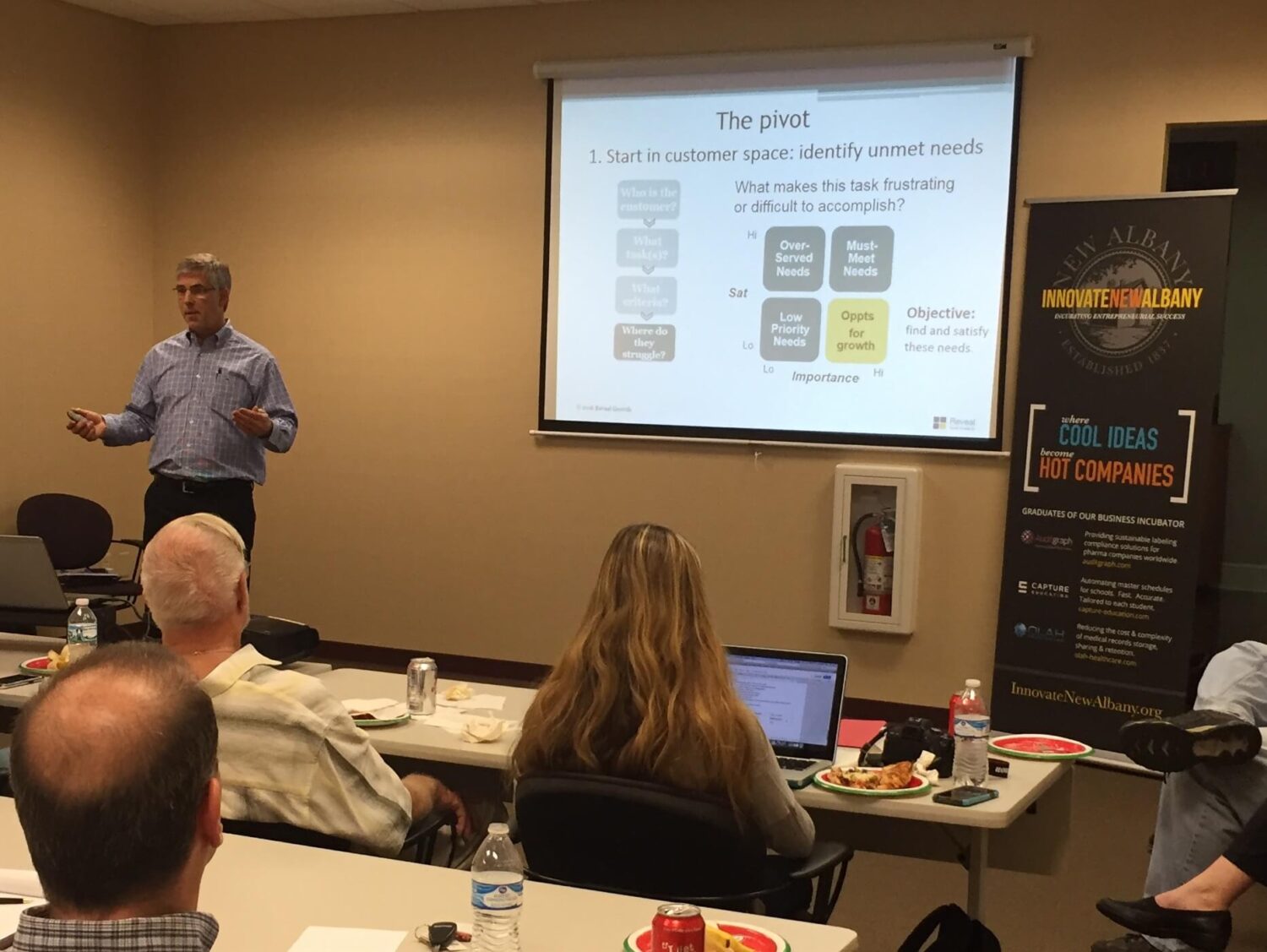TIGER Talk “Pivoting Innovation: New Ways to Drive Growth”
Urko recently had an opportunity to speak at Innovate New Albany, one of the startup incubators in the Central OH area. About 50 people attended from local companies, large organizations and startup entrepreneurs. Jessica Pirro of Innovation New Albany wrote the recap below. This information is essential for any leader who wants to drive innovation and growth in a predictable manner.
Recap: Urko Wood presented, “Pivoting Innovation: New Ways to Drive Growth” to a record crowd at Innovate New Albany on Friday, June 24.
Building a successful company is not simple – there are many unforeseen obstacles inhibiting one’s success. One of the biggest obstacles for any startup is trying to determine what the customer wants, says Urko Wood, President and Founder of Reveal Growth Consultants.
Urko presented, “Pivoting Innovation: New Ways to Drive Growth” to a record crowd at Innovate New Albany on Friday, June 24. (TIGER Talks are offered free of charge, and cover the topics of Technology, Innovation, Growth, Entrepreneurship and Responsibility. The luncheon series is designed to help entrepreneurs “earn their stripes” toward starting and running a successful business).
Determining if a new product will be successful is hard to predict. A common mistake that many companies make is developing an offering that customers do not want. Deciding if a product or service will be useful to the target customer is not an easy task. Wood’s solution to this problem is to ask customers what they are trying to accomplish, not their opinions about the product or service itself. This enables entrepreneurs to identify the customers’ true needs independent of solutions.
Wood believes there are two main parts to innovation:
- Identifying a customer’s unmet need
- Satisfying that need
Wood pointed out that, although Lean Startup is trying to bring science to innovation and entrepreneurship, the best way to do this and accelerate learning is to identify the customers’ unmet needs before building a prototype or minimum viable product (MVP).
Wood pointed out that in good science, the problem is clearly identified before the solution hypothesis is generated or any experiments are run. Doctors are trained to conduct a diagnosis, for example, before prescribing treatment. For a doctor to prescribe treatment without first conducting a diagnosis would be considered medical malpractice. Yet, many companies are practicing marketing malpractice by moving into rapid prototyping before they have identified the customers’ needs. The problem is that most companies don’t know how to conduct a customer diagnosis to determine their needs.
The “pivot” Urko referred to is the act of separating innovation into two different steps:
- First identify what functional, emotional, and social tasks customers are trying to accomplish in your market space
- Then, and only then, launch prototypes or minimum viable products (MVP) to test the solution.
When an entrepreneur asks his target customers, “What do you want?” they often think they are being asked about solutions. Instead, Wood says ask, “What do you want to accomplish?” and “Why is that important do you?” This reveals opportunities for innovation and makes it possible to uncover the functional, emotional, and social tasks that customers are trying to accomplish, their true needs, which are readily available to be discovered.
Wood says that the reason companies move into prototyping prematurely and have high failure rates is because they have accepted the misbelief that “Customers cannot tell us what they want.” In fact, customers can tell us what they want if we focus on what they want to accomplish rather than on product or service specifications.
“If I had only one hour to save the world, I would spend fifty-five minutes defining the problem, and only five minutes finding the solution” – Albert Einstein
Einstein understood that the quality of our solutions is directly related to how well we define the problem. Just as “A well-defined problem is half solved,” so “A customer need well-defined is half-satisfied.”
The Pivot: Start in “customer space” first to identify their unmet needs. The five questions Wood suggests entrepreneurs answer before building prototypes are:
- Who is the target customer? (For whom do you want to create value?)
- What is the primary task(s) target customers are trying to get done with your offering?
- What criteria do they use to measure success when executing this task(s)?
- Where in the execution of this task(s) are they struggling today given current solutions?
- How can you help them accomplish this task(s) better?
Wood says that all five of these questions can and should be answered by talking with customers before developing a prototype or starting the Lean Startup iterative process.
Once there is clarity about the customer’s needs, then the process of generating winning solutions can be done much more effectively. This is the way to ensure a tight fit between what customers want and what companies actually deliver.
Bottom line – predictable innovation is a two-step process:
- First, discover the customer’s unmet needs
- Then execute the iterative process of prototyping to improve the solution.
By Jessica PIrro. (This article was originally posted on the Innovate New Albany Website here.)





